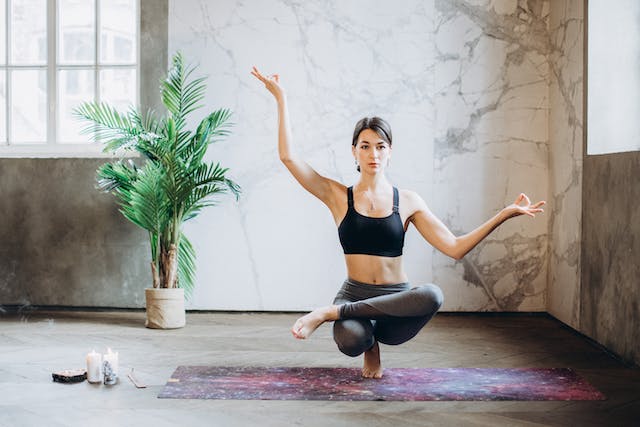Yoga is more than just physical exercise; it’s a holistic practice that connects the mind, body, and spirit for overall well-being. With its roots in ancient Indian traditions, the word “yoga” means union, symbolizing the harmonious connection between various aspects of our existence
Which yoga is best for beginners?
For beginners, Hatha yoga is a great way to start. It provides a gentle introduction, emphasizing basic poses and breathing techniques. As you advance, trying out Vinyasa or Iyengar can bring variety and challenge. Remember, it’s not a competition—listen to your body and go at your own pace.
How should a beginner start yoga?
Starting a yoga journey only requires a few basics – a comfortable mat, loose clothing, and an open mind. Begin with simple poses like Mountain Pose, Downward Dog, and Child’s Pose. Online tutorials and beginner classes offer valuable guidance. Take it easy, breathe deeply, and let your body adjust gradually.
The Benefits of Practicing Yoga
The benefits of doing yoga go beyond just flexibility and toned muscles. Yoga acts as a stress reliever, promoting relaxation and mental well-being. It also improves posture, enhances balance, and contributes to a healthier lifestyle. Engage in yoga not just for the physical advantages but for the peace it brings to your mind and spirit.
How to Improve After Starting
Yoga is a step-by-step journey, and progress comes with regular practice. Be patient, acknowledge small achievements, and pay attention to your body. As you get more familiar with poses, you’ll naturally improve your technique. Consider joining occasional classes for guidance and corrections from experienced instructors.
Beginning Yoga Articles
Beginning yoga as a newcomer can feel overwhelming. Find articles made for beginners that share insights, tips, and encouragement. These resources simplify the practice, making your journey more enjoyable and rewarding. Whether you’re learning basic poses or seeking advice on creating a routine, articles focused on beginners offer valuable support.

Different Types of Yoga Asanas
Yoga poses, known as asanas, come in a delightful variety. From the grounding Mountain Pose to the empowering Warrior poses, each serves a unique purpose. Explore the world of asanas to find those that resonate with you. Whether you prefer gentle stretches or dynamic flows, there’s an asana for every mood and goal.
Asanas: Meaning, Definition, and Purpose
Asanas form the foundation of yoga, combining movement and stillness in harmony. The word ‘asana’ means ‘pose,’ and these postures aim to align and strengthen the body. Each asana has a specific purpose, targeting particular muscle groups, improving flexibility, and promoting a mindful connection between body and breath.
Simple Steps to Start a Home Yoga Practice
Setting up a home yoga practice is easier than you might think. Choose a quiet space, unroll your mat, and start with simple poses. Use online resources, such as videos or written guides, to structure your practice. Consistency is crucial, so make it a regular habit. Your home can transform into a sanctuary for self-discovery and well-being.
Simple tips and tricks :-
- Do a Bit Every Day: Even a tiny yoga stretch daily is better than a big one once in a while.
- Listen to Your Body: If it feels too hard, just take it easy or stop for a bit.
- Breathe Calmly: When you move, breathe slow and steady – it helps a lot!
- Try Different Moves: Some poses might feel better than others, so try them out.
- Stay in the Now: Forget about yesterday and tomorrow, focus on today’s moves.
- Get Comfy Gear: A good mat and comfy clothes make yoga more enjoyable.
- Celebrate Little Wins: Even if it’s just touching your toes a bit more, it’s a win!
- Rest When Tired: Lie down anytime you need a break – it’s called the ‘Rest Pose’.
- Use Yoga Tools: Blocks and straps can make some poses much easier.
The Importance of a Daily Yoga Practice
Consistency is the heartbeat of progress in yoga. A daily practice, even if short, builds a sense of routine and discipline. It strengthens your connection with the practice, both physically and mentally. Think of it as a daily date with yourself, a moment of self-care that creates positive ripples throughout your day.
Morning Yoga for Beginners
Beginning your day with yoga is a gift to your body and mind. Start with simple stretches to wake up your muscles. Include breathing exercises to invigorate your senses. A brief morning yoga routine can uplift your mood, increase your energy, and set a positive mindset for the day ahead.
Can I teach myself yoga?
Absolutely! With a wealth of online resources, self-guided yoga journeys are becoming more popular. Follow instructional videos, read guides, and listen to your body. However, attending a few classes, either in-person or virtually, can offer crucial corrections and insights into proper form.
Does yoga hurt at first?
Although yoga isn’t supposed to be painful, you might feel some discomfort as your body adapts to new movements. If you experience sharp pain, it’s a signal to ease off or modify the pose. Over time, as flexibility and strength improve, any initial discomfort can transform into a sense of accomplishment.
Also read: 7 Most Popular Yoga Styles in the World
How do I start yoga at home for beginners?
Building a home yoga sanctuary is easier than it seems. Designate a quiet space, roll out your mat, and begin with beginner-friendly online classes. Make it a part of your daily routine, turning it into a ritual. Before you know it, your home will become a haven for peace and self-discovery.
What time of day is yoga best?
The beauty of yoga is its adaptability to any time of day. Morning sessions can invigorate, preparing you for the day ahead, while evening practice can unwind the knots of daily stress. Experiment and find the time that aligns with your energy levels and schedule.
What is the age limit for yoga for beginners?
Yoga has no age restrictions – it’s a practice for the young, the old, and everyone in between. From toddlers to seniors, there are modified poses catering to all ages and abilities. It’s never too late or too early to start.
Should beginners do yoga every day?
Yes! Consistency is the cornerstone of progress. Daily practice enhances muscle memory, flexibility, and mental well-being. Even a short daily routine can yield profound benefits, making yoga a lifelong companion.
Is yoga better than the gym?
Yoga and gym workouts cater to different needs. The gym emphasizes strength training, while yoga focuses on flexibility, balance, and mindfulness. The ideal choice depends on your personal goals and preferences. Many find a combination of both to be a perfect recipe for overall fitness.
Does yoga burn fat?
Indeed, yoga contributes to weight loss. While it may not burn as many calories as high-intensity workouts, it increases awareness of the body and mind, fostering healthier choices. The mindfulness cultivated in yoga can positively impact eating habits, aiding in weight control.
Which is better cardio or yoga?
The choice between cardio and yoga depends on your fitness goals. Cardio enhances cardiovascular health and burns calories, while yoga focuses on flexibility, balance, and mental well-being. A balanced approach, incorporating both, can offer comprehensive fitness benefits.
Is yoga better than walking?
Yoga and walking serve different purposes. Walking is an excellent cardiovascular exercise, while yoga offers a holistic approach to fitness, combining strength, flexibility, and mental well-being. The ideal choice depends on your fitness goals and preferences.
Here’s a table summarizing details specifically for beginners starting yoga:
| Aspect | Yoga for Beginners |
| Introduction | Gentle Introduction to Yoga Poses and Breathing Techniques |
| Focus | Basic Poses, Building Foundation |
| Benefits | Improved Flexibility, Balance, Mental Calmness |
| Ideal For | Individuals New to Yoga |
| Equipment | Minimal (Mat, Blocks, Straps) |
| Accessibility | Suitable for Beginners, Anywhere with Minimal Space |
| Routine Structure | Simple Sequences, Easy Poses |
| Mindfulness | Emphasis on Mind-Body Connection |
| Guidance | Beginner-Friendly Online Videos, Written Guides |
| Progression | Gradual Increase in Difficulty |
| Motivation | Celebrating Small Achievements |
This practice, tailored for those new to yoga, introduces gentle poses and foundational breathing techniques. With minimal equipment and accessibility, beginners can embark on a journey that enhances flexibility, balance, and mental calmness .


